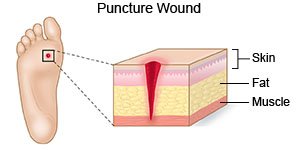Puncture Wounds in Children
Medically reviewed by Drugs.com. Last updated on Apr 6, 2025.
What is a puncture wound?
A puncture wound is a hole in your child's skin made by a sharp, pointed object. The area may be bruised or swollen. Your child may have bleeding, pain, or trouble moving the affected area.
 |
How is a puncture wound diagnosed?
Your child's healthcare provider will examine your child's injury and look for signs and symptoms of infection. He or she will also check how well your child can move the injured area and ask about numbness. Tell your child's provider how and when your child was injured, especially if it was an animal bite.
- An x-ray, ultrasound, CT, or MRI may show deeper injuries or foreign objects. Your child may be given contrast liquid to help the injury or objects show up better in the pictures. Tell the healthcare provider if your child has ever had an allergic reaction to contrast liquid. Do not enter the MRI room with anything metal. Metal can cause serious injury. Tell the healthcare provider if your child has any metal in or on his or her body.
How is a puncture wound treated?
Treatment depends on how severe the wound is and when the injury happened. Your child may need any of the following:
- Wound cleaning may be needed to remove dirt or debris. This will decrease the chance of infection. Before the wound is cleaned, your child will be given medicine to numb the area.
- Medicine to treat pain or prevent a bacterial infection may be given.
- A tetanus vaccine may be needed. This depends on the type of puncture wound and if your child is current on his or her vaccines. Tell your child's healthcare provider about your child's vaccine history.
- Surgery may be needed if your child's wound needs a lot of cleaning or removal of deep foreign objects. Your child's wound may be left open until it heals, or it may be closed with stitches.
How can I manage my child's symptoms?
- Elevate your child's injured area above the level of his or her heart, if possible, as often as you can. This will help decrease swelling and pain. Prop the injured area on pillows or blankets to keep it elevated comfortably.
When should I seek immediate care?
- Your child has severe pain.
- Your child has numbness or tingling in the area of his or her wound.
- Your child's wound starts bleeding and does not stop, even after you apply pressure.
When should I call my child's doctor?
- Your child has new drainage or a bad odor coming from the wound.
- Your child has a fever or chills.
- Your child has increased swelling, redness, or pain.
- Your child has red streaks on his or her skin coming from the wound.
- You have questions or concerns about your child's condition or care.
Care Agreement
You have the right to help plan your child's care. Learn about your child's health condition and how it may be treated. Discuss treatment options with your child's healthcare providers to decide what care you want for your child. The above information is an educational aid only. It is not intended as medical advice for individual conditions or treatments. Talk to your doctor, nurse or pharmacist before following any medical regimen to see if it is safe and effective for you.© Copyright Merative 2025 Information is for End User's use only and may not be sold, redistributed or otherwise used for commercial purposes.
Further information
Always consult your healthcare provider to ensure the information displayed on this page applies to your personal circumstances.
